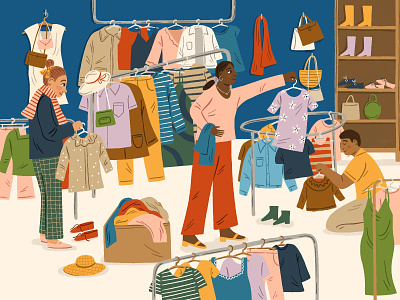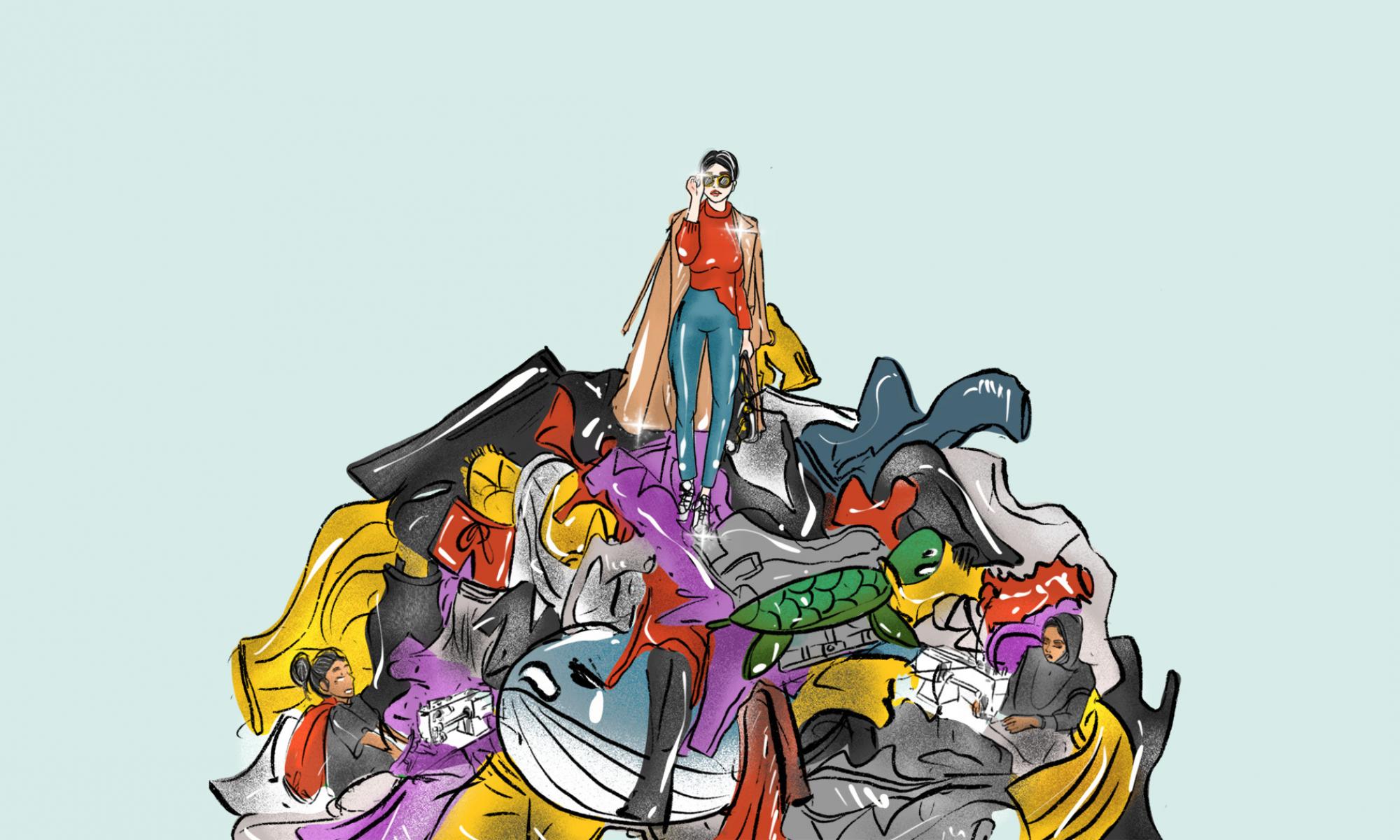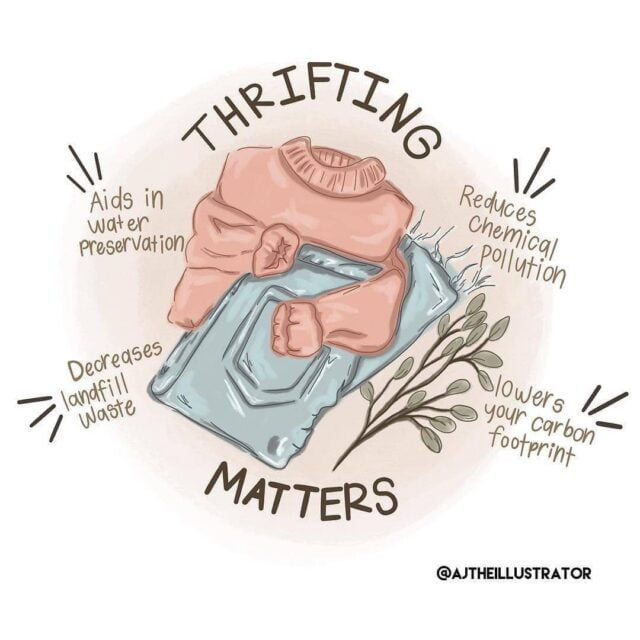Editor’s Note: FII’s #MoodOfTheMonth for July 2021 is Sustainability. We invite submissions on the diverse aspects of sustainability throughout the month. If you’d like to contribute, kindly email your articles to sukanya@feminisminindia.com
Of the many trends that have risen in fashion in the past few years, thrift shopping is definitely one of the most relevant ones. Make no mistake, however, thrift shops have been around for ages. Organisations like Goodwill in the USA and Indian marketplaces like Sarojini Nagar in Delhi and New Market in Kolkata are among the most popular spaces for thrift shopping.
With trends dominating the fashion scene and the coming of fast fashion, the buying of clothes moved on from simply being an occasional activity to a more frequent pursuit. This was capitalised by several fast fashion brands and websites by making trendy clothes available at cheap prices
However, with the recent rise in Instagram thrift shops and conscious consumers, thrift shopping has found a fresh wave of popularity.

Fast fashion and its damning consequences
Buying clothes has been both a splurge and a necessity. New clothes came into households with festivals, familial occasions or changes of seasons. However, the landscape of fashion and subsequently, people’s attitude towards it has witnessed some change.
With trends dominating the fashion scene and the coming of fast fashion, the buying of clothes moved on from simply being an occasional activity to a more frequent pursuit. This was capitalised by several fast fashion brands and websites by making trendy clothes available at cheap prices.
Fast fashion may have made fashionable clothing cheaper, but at what cost? Besides the various forms of pollution, fast fashion factory workers are also exploited in the process. Labour is sourced at cheap rates from developing countries and the labourers are often underpaid, and exposed to toxic chemicals without proper safety measures being taken
Though the fact remains that these retail outlets promote a terribly unhealthy attitude towards body image with regards to sizeism and attract customers with items that they will barely wear till the next season, these outlets continue to attract huge numbers of consumers.

Fast fashion, its affordability and accessibility directly contribute to the alarming rates of textile waste that is produced. A huge percentage of the clothes being sold out in minutes end in landfills much quicker than they did fifty years ago. In 2018, the world produced more than 17 million tonnes of textiles, according to the Environmental Protection Agency, compared to the 2 million, 50 years ago. Out of that massive pile, 11.3 million tonnes entered landfills. This causes soil pollution through mountains of unnecessary landfills, contaminates water, furthers energy pollution and much more.
Also read: The Ugly Truths Of Fast Fashion And My Journey With Ecofeminism
Fast fashion may have made fashionable clothing cheaper, but at what cost? Besides the various forms of pollution, fast fashion factory workers are also exploited in the process. Labour is sourced at cheap rates from developing countries and the labourers are often underpaid, and exposed to toxic chemicals without proper safety measures being taken.
Thrift shopping: An eco-friendly and sustainable alternative
For long, thrift shopping was seen as a derogatory activity that warranted mocking. Today, with conversations on eco-consciousness and accessibility, it is fast becoming a popular choice. Thrift shopping essentially keeps clothes and their components in circulation for a longer time.

This reduces the need for manufacturing new ones and prevents pollution, saves up on energy as well as finite resources. Moreover, even recycling textiles can require huge amounts of energy which thrift shopping limits. Thrift shopping is eco-friendly and sustainable, even for fashion bugs. If you are used to buying clothes of latest trends, thrift shops are known to offer them at cheaper prices.
As a result, they have attracted the attention of a huge demographic, mostly college-goers and young professionals. By thrift shopping, not only are you saving up while getting trendy clothes, but also contributing towards saving the earth.
Is thrift shopping the ultimate sustainable solution?
Thrifting, for all that it is worth, has some flaws. For one, is not quite size-inclusive. This is not to say that there is a wide range of sizes available at all regular outlets either, but some fast fashion websites do have more sizes than others. Sustainable brands often either do not have larger sizes, or are not affordable for most people.
it is simply not enough if thrift shopping is accessible to more people. The idea of sustainable fashion itself is to shop less, shop sustainably and use what is shopped for a longer time. It is this basic thought that needs to be more widely perpetuated to find the best ways to narrow down consumption within one’s needs and abilities
Moreover, larger sized clothes are either made to be unflattering or are mostly not at par with how fashionable smaller sizes are. Thrift shops too, usually stock limited clothes of larger sizes. As a result, larger-sized buyers might often find themselves behind on trends that others might be able to take part in and turn to fast fashion for better accessibility, easier affordability and availability of the latest trends.

Of course, it is not entirely the fault of thrift shops as they are simply sourcing what is available. However, it would definitely be more inclusive if they stocked more options of larger sizes to promote inclusivity.
Thrift shopping is a great idea but with the rise of Instagram thrift shops and other online avenues, the availability and accessibility to thrifting have increased. Subsequently, this has also given rise to the purchase of more clothes at cheaper rates. To think about it, reusing clothes from one’s closet for years, even if they have been bought from fast fashion brands can be more useful than thrifting frequently.
Also read: Building An Eco-Friendly Wardrobe: Sustainable Fashion Must Not Just Remain A Buzzword
Therefore, it is simply not enough if thrift shopping is accessible to more people. The idea of sustainable fashion itself is to shop less, shop sustainably and use what is shopped for a longer time. It is this basic thought that needs to be more widely perpetuated to find the best ways to narrow down consumption within one’s needs and abilities.
Sudarshana Ganguly is currently pursuing a Bachelors in English from Jadavpur University. When she’s not procrastinating or falling victim to impulse retail therapy, she can be found learning new languages, fangirling over her favourite kpop acts and daydreaming about herself as a future magazine editor. She is passionate about fashion, especially about how it can be made more sustainable and inclusive. You may find her on Instagram
About the author(s)
Sudarshana Ganguly is currently pursuing a Bachelors in English from Jadavpur University. When she’s not procrastinating or falling victim to impulse retail therapy, she can be found learning new languages, fangirling over her favourite kpop acts and daydreaming about herself as a future magazine editor. She is passionate about fashion, especially about how it can be made more sustainable and inclusive.





